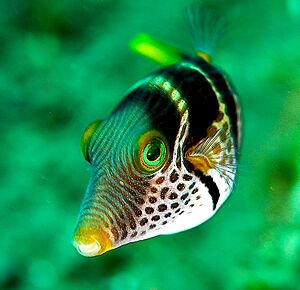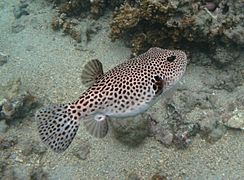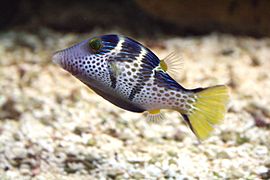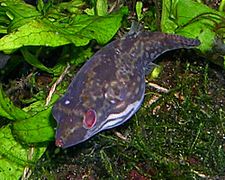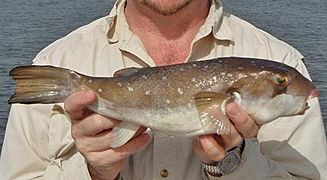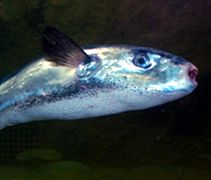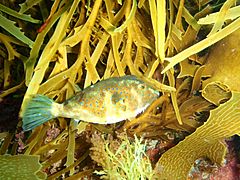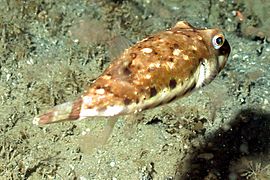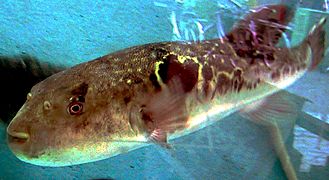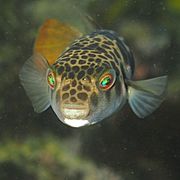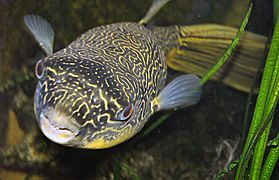Pufferfish facts for kids
Quick facts for kids PuffersTemporal range: Lutetian–Holocene
|
|
|---|---|
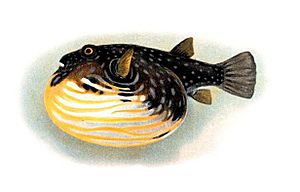 |
|
| Inflated white-spotted puffer | |
| Scientific classification |
|
| Kingdom: | Animalia |
| Phylum: | Chordata |
| Class: | Actinopterygii |
| Order: | Tetraodontiformes |
| Suborder: | Tetraodontoidei |
| Family: | Tetraodontidae Bonaparte, 1832 |
| Type species | |
| Tetraodon lineatus Linnaeus, 1758
|
|
| Genera | |
Pufferfish are a family of fish that mostly live in the ocean or in places where fresh water mixes with salt water (like estuaries). They are also known by many other fun names like puffers, balloonfish, blowfish, globefish, and swellfish. They look a bit like porcupinefish, but their spines are usually hidden until they puff up.
Many pufferfish are poisonous. Some are among the most poisonous animals with backbones in the world! Their internal organs, like the liver, and sometimes their skin, contain a very strong poison called tetrodotoxin. This poison is very dangerous to most animals if eaten. However, in countries like Japan (where it's called fugu), Korea, and China, some types of pufferfish meat are a special food. Only chefs who are highly trained know how to prepare it safely. Other types of pufferfish, like the northern puffer, are not poisonous and are eaten in other places.
One amazing pufferfish, Torquigener albomaculosus, was called "the greatest artist of the animal kingdom" by David Attenborough. This is because the male pufferfish creates incredible, complex patterns in the sand to attract females!
Contents
What are Pufferfish?
The name "Tetraodontidae" comes from two Greek words: tetra meaning "four" and odoús meaning "teeth." This is because pufferfish have four large teeth. These teeth are fused together into two plates, one on top and one on the bottom. They use these strong teeth to crush the hard shells of crustaceans (like crabs) and mollusks (like snails), which are their favorite foods.
Pufferfish Body Features
Pufferfish are usually small to medium in size. However, some species, like the Mbu pufferfish, can grow quite large, over 50 centimeters (about 20 inches) long!
Pufferfish have a special beak-like mouth with their four fused teeth. They don't have ribs, a pelvis, or typical pectoral fins like most fish. These missing bones and fins are part of their amazing defense system.
Instead of scales, pufferfish have spiny skin. These spines can cover their whole body or just parts of it. The spines are usually small and might not be seen until the fish puffs up.
Where Pufferfish Live
Pufferfish are most common in warm, tropical areas around the world. They are less common in cooler places and are not found in very cold waters at all.
Most pufferfish live in the ocean or in brackish water (a mix of fresh and salt water). But about 35 species live their entire lives in fresh water. These freshwater puffers are found in South America, Africa, and Southeast Asia.
Pufferfish Defenses and Life
Pufferfish are not very fast swimmers. They move by wiggling their small fins. This makes them very good at turning and moving precisely, but also quite slow. This slowness makes them an easy target for predators.
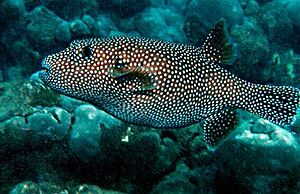
Their first defense is their excellent eyesight and a sudden burst of speed. They can quickly dart away from danger.
If a predator still chases them, the pufferfish has an amazing trick! They can quickly suck in a lot of water (or air if they are out of the water). This fills their super stretchy stomach, making them much larger and almost perfectly round like a ball. When they puff up, their hidden spines stick out, making them a very spiky, unappetizing meal.
Predators that try to eat a puffed-up pufferfish might choke. Even if they manage to swallow it, they could get sick or even die from the tetrodotoxin poison. This strong poison is mostly in the puffer's ovaries and liver, but also in smaller amounts in their intestines and skin. It can be deadly to humans.
Baby pufferfish are also protected by this poison. It's on their skin, so predators spit them out if they try to eat them. Not all pufferfish are deadly poisonous. For example, the northern puffer's meat is not toxic, though its organs can be. The level of poison can also vary greatly between different pufferfish. Some animals, like sharks, can eat pufferfish without being harmed.
Pufferfish can move their eyes independently, just like a chameleon. Many species can also change their skin color or patterns to match their surroundings. Some puffers have bright colors and patterns and don't try to hide. This is a warning sign to predators that they are poisonous.
Interestingly, dolphins have been seen playing with pufferfish. It seems they might be trying to get a little bit of the puffer's toxin to feel a strange, trance-like state!
Pufferfish Reproduction
Many ocean pufferfish have a stage where their young float in the open ocean. Spawning happens when males gently push females to the water surface. The eggs are round and float. They hatch after about four days. The baby pufferfish are tiny but look like miniature puffers. They need to eat within a few days of hatching.
Freshwater pufferfish have different ways of reproducing. For example, dwarf puffers have a special courtship dance. The male follows the female, showing off his unique crests. If the female accepts, she leads him into plants or other hiding spots to lay her eggs. The male might help her by rubbing against her side.
Other freshwater puffers lay their eggs on a flat surface, like a smooth rock. The male then guards the eggs until they hatch. He carefully blows water over them to keep them healthy. Once the young hatch, they are on their own.
In 2012, scientists discovered that male Torquigener albomaculosus pufferfish create large, complex circular patterns in the sand on the seabed in Japan. These amazing sand circles are built to attract females and provide a safe place for them to lay their eggs.
What Pufferfish Eat
Pufferfish diets change depending on where they live. They usually eat algae and small invertebrates (animals without backbones, like worms or tiny crabs). If food is scarce, they can survive on just plants, but they prefer to eat both plants and animals.
Larger pufferfish use their strong, beak-like teeth to crack open clams, mussels, and other shellfish. Some pufferfish also have different hunting styles, from hiding and ambushing their prey to hunting in open water.
- Spots, stripes and elaborations
-
Elaborate skin pattern of the giant or mbu puffer
Pufferfish Poisoning
Pufferfish can be very dangerous if not prepared correctly. People can get sick or even die from eating pufferfish that wasn't handled by a trained chef. The poison, tetrodotoxin, can make your tongue and lips feel numb. It can also cause dizziness, vomiting, and muscle weakness. In severe cases, it can stop a person from breathing. People who survive for more than 24 hours usually recover, sometimes after being in a coma for a few days.
Scientists believe that the tetrodotoxin in pufferfish comes from bacteria that live in the fish's stomach.
-
Man with a guineafowl puffer in Costa Rica
-
Fisherman handpicks a puffer from his day's catch before throwing it back to prevent poisoning. Tarkwa bay, Lagos
Warnings in Different Countries
In September 2012, the Bureau of Fisheries and Aquatic Resources in the Philippines warned people not to eat pufferfish. This warning came after some local fishermen died after eating pufferfish for dinner. They stated that pufferfish toxin is 100 times stronger than cyanide.
In Thailand, pufferfish (called pakapao) are sometimes eaten by mistake. They can be cheaper than other fish, and people might not know how dangerous they are. Many people are hospitalized, and some even die from the poisoning.
In the United States, there have been reports of people getting sick after eating pufferfish caught near Titusville, Florida. Symptoms included numbness and tingling in the lips and mouth. Because of this, Florida has banned catching pufferfish in certain areas.
How Poisoning is Treated
If someone is poisoned by pufferfish, doctors try to help them by cleaning out their stomach and giving them medicine like activated charcoal. They also provide life support until the body can get rid of the poison.
See also
 In Spanish: Pez globo para niños
In Spanish: Pez globo para niños
- Shimonoseki – A Japanese city famous for its pufferfish dishes.
- Toado – A common Australian name for local types of pufferfish.


